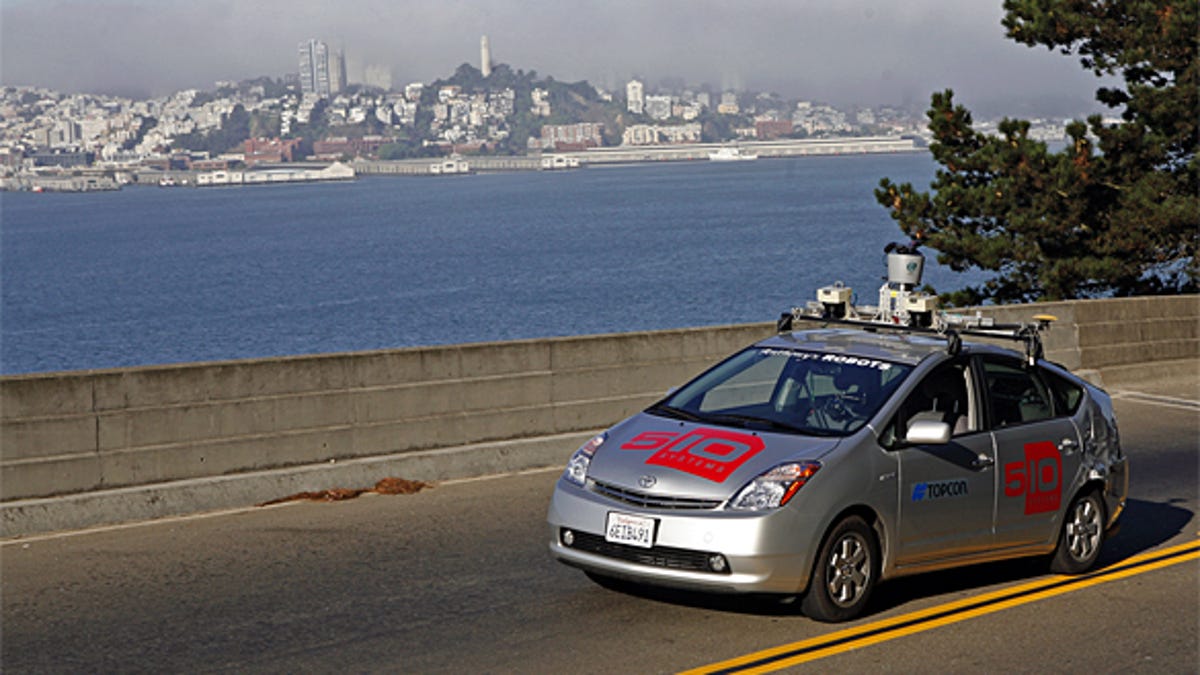Robotic Prius takes itself for a spin around SF
A Silicon Valley engineer and longtime robot-tinkerer creates an autonomous vehicle that was able to drive itself last week through San Francisco and over the Bay Bridge.

An unusual motorcade made its way across the San Francisco-Oakland Bay Bridge early one morning last week: a silver Toyota Prius, complete with police escort and camera crew, but with no driver at the wheel.
The robotic Prius was the invention of Anthony Levandowski, 28, a computer engineer who lives in San Francisco, works in Silicon Valley, and built the so-called "Pribot" in his spare time.
"Some people like to work on hot rods, boats, or airplanes," Levandowski said afterward. "I love robots."
Pribot's real-world test started on September 7 at Pier 7, a nondescript slice of San Francisco's often-foggy waterfront, around 7:30 a.m. The autonomous vehicle drove along the Embarcadero, took a right on Harrison Street, turned onto the bridge itself, and exited at Treasure Island.
The result? Years of hard work paid off. No little old ladies were run off the road. Pribot's trek, Levandowski said, took place without incident, save the car scraping its left side as it drove up the ramp exiting the Bay Bridge.
This was far from his first experiment with self-guided vehicles. As a student at the University of California at Berkeley in 2004, Levandowski was part of a graduate student team that created a robotic motorcycle called Ghostrider to enter DARPA's Grand Challenge.
It was an ambitious effort (two-wheel vehicles can be unstable at low speeds, and Ghostrider was weighed down with a hefty load of electronics). And it proved to be too clunky, or perhaps too pioneering, to win the DARPA contest. Ghostrider toppled over early on and couldn't get up.
But the experience did cement Levandowski's interest in self-guided vehicles. After graduation, he worked at 510 Systems, a Berkeley company that builds and sells computer systems used in machine control and robotics. (Trivia: 510 was involved in processing laser-scanned imagery for Radiohead's "House of Cards" video; the raw 3D image data has been posted on code.google.com.)
In preparation for last week's 25-minute drive, Levandowski drove the route in advance a few days before, scanning the surroundings with a pulsed laser. "We built a precise map of what the area downtown looks like," he said.
That's what Pribot used to navigate the course. More precisely, the 'bot relied on a combination of GPS, inertial guidance, and a pair of infrared lasers that scanned its surroundings and compared its location with the previously built 3D map. The lasers are rated Class 1, meaning they're so low-power that they're safe if they shine into a human eye.
Building the 3D model of San Francisco's waterfront is even more complicated than it sounds, mostly because so much can change. Cars move. Scaffolding can change a building's appearance. Pedestrians will probably not be in the same place days later. The solution is a probabilistic approach: "You build a map, you assume it's true to a certain confidence interval," Levandowski said.
Normal GPS signals might be precise enough for human drivers who need accuracy down to, say, a radius of tens of meters. That's enough to know what street you're driving on or how far away the nearest Starbucks is.
Yet because robotic vision remains nowhere near as flexible as human eyesight, 'bots need more accuracy than GPS can generally deliver. Levandowski found a solution in the RTK base station sold by Topcon, a Pribot sponsor, which typically sells to farmers aiming to do carefully aimed seeding and fertilizing. RTK boasts an accuracy of one inch or less, as long as the base station is no more than 3 to 6 miles away.
Pribot's morning bridge crossing will air on an upcoming episode of Prototype This!, a new Discovery Channel show that will debut on October 15, and which is being made on San Francisco's Treasure Island by Beyond Productions. Discovery describes it as a way "to experience firsthand as inventions come to life."
Although Levandowski works in Mountain View, Calif., as an engineer for Google, he stresses that this project is unrelated to his employer. He created his own company for this venture--with its own what-if-the-robot-squashes-a-human liability insurance, of course--called Anthony's Robots, which was registered with the state of California in June.
The drive from San Francisco to Mountain View on U.S. 101 is 40 miles. During rush hour it can be a miserable inching-along commute, comparable to the worst that Washington, D.C.'s Beltway or Philadelphia's Schuylkill Expressway can offer.
It was frustration born of that drive (and similar experiences on other SF-area freeways) that gave birth to Pribot. "I commute a lot," Levandowski said. "It's really stressful...If I could be more productive and be safer, while doing that, that's (better). I'm an engineer. I like tackling hard problems and solving them."
Automotive technology is already moving in this direction, of course. Some current models in Nissan's Infiniti lineup offer lane departure prevention, which uses sensors to monitor lane markings, sound an audible alert when drifting is detected, and gently apply selected brakes to nudge the vehicle back into the proper lane. Lexus and Volvo offer similar systems.
If cars already are smart enough to do that, why not give a 'bot even more control of a car, at least in stop-and-go traffic? Levandowski thinks an aftermarket kit will be available within three years to do just that. "It will keep you in the lane that you're in, gently steer left or steer right, follow the curves, and pace itself against the vehicle in front of you," he said.
"The technology for being able to improve your convenience and safety while on the freeway is just around the corner," he added. "I want to be the one to provide that."

